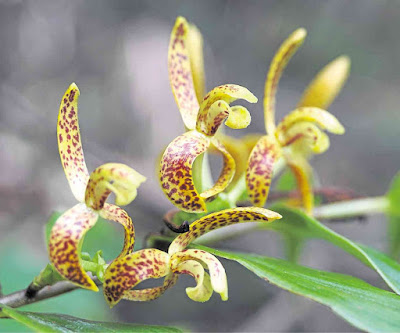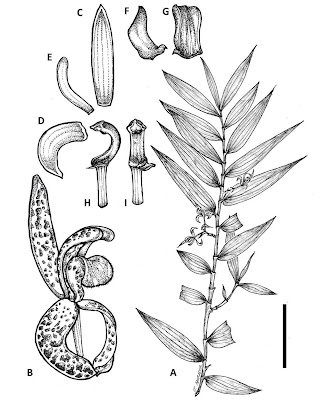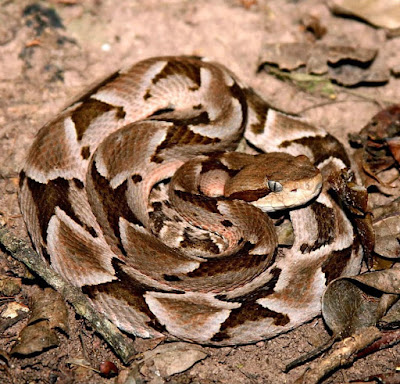[Most Recent Entries] [Calendar View]
Sunday, August 25th, 2019
| Time | Event | ||||
| 12:42a | [Botany • 2019] Pseuderia samarana (Orchidaceae: Podochileae, Eriinae) • A New Species and Genus Record from the Philippines
Abstract A new species of orchid, Pseuderia samarana Z.D. Meneses & Cootes (Orchidaceae: Podochileae, Eriinae) from Samar Island, Philippines is described and illustrated. This is also a new generic record for the country. It is distinguished from other known species by the combination of the following characters: relatively smaller lanceolate leaves, minutely cuspidate bracts, 2-flowered raceme borne on short peduncle, narrower labellum, and entire clinandrium margins. Notes on its habitat and ecology, distribution, conservation status, and comparison with other closely related New Guinean speciesare also presented. Keyword: Eriinae, Orchidaceae, Philippines, Podochileae, Pseuderia samarana, Samar Island Pseuderia samarana Z.D. Meneses & Cootes, sp. nov. Diagnosis. Pseuderia samarana shares similarity with both P. frutex and P. floribunda but the new species significantly differs in its 2-flowered inflorescence (vs. 3‒ 5-flowered in other two species), much narrower labellum (2.5 mm wide vs. 4.5‒5 mm) and entire clinandrium margins (vs. serrulate in P. frutex and dentate in P. floribunda). .... Etymology. This new orchid species is named after the type province, Samar. The province forms a large partion of the Samar Island Natural Park. It has several rolling limestone formations which supports a distinct forest type. Samar also houses the headquarters of the park’s Protected Area Management Board which is the governing and managing office of the natural park Zhereeleen D. Meneses and James Edward Cootes. 2019. Pseuderia samarana (Orchidaceae), A New Species and Genus Record from the Philippines. Taiwania. 64(4); 353-356. DOI: 10.6165/tai.2019.64.353 In Samar, there’s a new orchid on the block newsinfo.inquirer.net/1156167/in-samar-t | ||||
| 1:35p | [Herpetology • 2019] Bothrops monsignifer • A New Species of Pitviper of the Genus Bothrops (Serpentes: Viperidae: Crotalinae) from the Central Andes of South America
Abstract We describe a new species of montane pitviper of the genus Bothrops from the Cordillera Oriental of the Central Andes, distributed from southern Peru to central Bolivia. The new species can be distinguished from its congeners by the characteristic combination of a dorsal body color pattern consisting of triangular or subtriangular dark brown dorsal blotches, paired dark brown parallel occipital stripes, a conspicuous dark brown postocular stripe, the presence of canthorostrals in some specimens, prelacunal fused or partially fused with second supralabial, one scale usually separating internasals, rostral trapezoidal, two canthals oval to rounded, similar size or slightly larger than internasals, three or four medial intercanthals, eight to twelve intersupraoculars, intercanthals and intersupraoculars keeled and frequently slightly keeled, supraoculars oval, one to three suboculars, two to three postoculars, loreal subtriangular, two to six prefoveals, subfoveals absent, two or none postfoveals, one or two scales between suboculars and fourth supralabial, seven or eight supralabials, nine or eleven infralabials, 23–25 middorsal scales, 189–195 ventrals in females and 182–190 in males, 48–58 subcaudals in females and 54–63 in males, exceptionally undivided. The new species is apparently restricted to areas within Andean montane forests that are less humid and devoid of large trees. Keywords: Reptilia, Andes, Bolivia, morphology, Peru, phylogeny, pitviper species
Bothrops monsignifer sp. nov. Etymology: The specific epithet is derived from the Latin (noun) by the union of “mons” (=montane) + “ignifer” (=flame, fire or flash), meaning fire mountain or volcano, in allusion to the location where the first Bolivian specimen was photographed (Refugio Los Volcanes, department of Santa Cruz, Bolivia). Juan Timms, Juan C. Chaparro, Pablo J. Venegas, David Salazar-Valenzuela, Gustavo J. Scrocchi, Jairo Cuevas, Gerardo C. Leynaud and Paola A. Carrasco. 2019. A New Species of Pitviper of the Genus Bothrops (Serpentes: Viperidae: Crotalinae) from the Central Andes of South America. Zootaxa. 4656(1); 99–120. DOI: 10.11646/zootaxa.4656.1.4 | ||||
| 1:54p | [PaleoMammalogy • 2019] Casatia thermophila • A New Monodontidae (Cetacea, Delphinoidea) from the lower Pliocene of Italy Supports A Warm-water Origin for Narwhals and White Whales
ABSTRACT A new taxon of monodontid cetacean, Casatia thermophila, gen. et sp. nov., is here described on the basis of a partial skull from lower Pliocene (5.1–4.5 Ma) marginal-marine deposits of Tuscany (central Italy). This new taxon belongs to Monodontidae based on the presence of a medial exposure of the maxillae anterior and lateral to the external bony nares; it mainly differs from all other named monodontids by the presence of a median depression of the premaxillae anterior to the premaxillary sac fossae and by a medial margin of the premaxillary-maxillary suture that does not parallel the anterolateral profile of the external bony nares. Our phylogenetic analysis, the first including all taxa of Monodontidae, recovers Casatia as a crown monodontid, more closely related to Delphinapterus than to Monodon and sister group of an unnamed taxon from the North Sea. The holotype of Casatia represents the first and only fossil monodontid from the Mediterranean Basin. Taking its place beside abundant fossils of strongly thermophilic marine vertebrates, such as the bull shark Carcharhinus leucas, the tiger shark Galeocerdo cuvier, and the extinct sirenian Metaxytherium subapenninum, Casatia thermophila represents the strongest evidence supporting the hypothesis that monodontids once thrived in low-latitude, warm-water habitats. On the basis of our phylogenetic reconstruction, early relatives of the extant monodontids might have adapted independently to the high-latitude, cold-water environments they currently master. The definitive disappearance of the Neogene thermophilic monodontids could be attributed to the cooling episode that accompanied the onset of long-term Northern Hemisphere glaciation around 3 Ma. SYSTEMATIC PALEONTOLOGY CETACEA Brisson, 1762 ODONTOCETI Flower, 1867 DELPHINOIDEA Gray, 1821 MONODONTIDAE Gray, 1821 CASATIA, gen. nov. Type and Only Known Species— Casatia thermophila, sp. nov. Etymology— The genus name honors Simone Casati, prominent amateur paleontologist who discovered most of the fossil vertebrates from Arcille (the locality where the holotype of Casatia thermophila was found) and author of several academic and popularizing works on the Pliocene marine vertebrates of Tuscany (Casati, 2007; Bianucci et al., 2009; Cigala-Fulgosi et al., 2009; Oddone et al., 2009; Casati and Oddone, 2011; Collareta et al., 2017, 2018). CASATIA THERMOPHILA, sp. nov. Etymology— The species name is from the Greek ‘thermós’ (= hot) and ‘philos’ (= loving), considering the warm-water habits of this extinct cetacean. Giovanni Bianucci, Fabio Pesci, Alberto Collareta and Chiara Tinelli. 2019. A New Monodontidae (Cetacea, Delphinoidea) from the lower Pliocene of Italy Supports A Warm-water Origin for Narwhals and White Whales. Journal of Vertebrate Paleontology. DOI: 10.1080/02724634.2019.1645148 |
| << Previous Day |
2019/08/25 [Calendar] |
Next Day >> |

















